Construction begins on school dome addition

The Vanguard School in Colorado Springs, CO is adding a Monolithic Dome to its campus. The building will serve as the junior high for the charter school and will house seventh- and eighth-graders.

The Vanguard School in Colorado Springs, CO is adding a Monolithic Dome to its campus. The building will serve as the junior high for the charter school and will house seventh- and eighth-graders.

A new Monolithic Dome now stands on the school grounds where a tornado came tearing through 23 years ago. Catoosa, Oklahoma, a suburb of Tulsa, was the site of a F4 storm in 1993 that killed seven people and injured many more. Thanks to a new Monolithic Dome, people at the school can now feel safe from another such storm.

The fall of the 2016-17 school year marks an exciting time at Wasuma Elementary School in Ahwahnee, California. A new domed gymnasium is now in full use. Built to serve the school and the community, it has been years in the making.

“Dome fever has spread to the Sooner State!” says Bill Kramer in the Oklahoman. Monolithic domes have gained popularity in recent years. In fact, domes are in use by eight rural school districts around the state. NewsChannel 4 featured monolithic domes and their growing popularity in a news report hosted on their website, KFOR.com. Their broadcast highlighted backyard monolithic dome tornado shelters built by dome-builder and educator, Verlin Fairchild. Monolithic domes are definitely big news in Oklahoma.
Recently, the Division of State Architects in California approved the construction of a Monolithic dome gymnasium, the first of its kind to be used for educational and school purposes in California, for Wasuma Elementary in the Bass Lake School District, reports Alan Wileman in the Sierra Star.
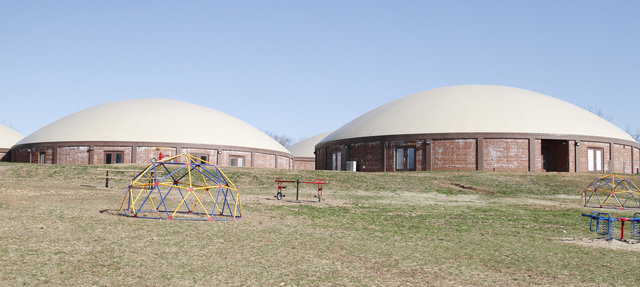
This week, Monolithic Dome Schools in Locust Grove, Oklahoma were featured on KSL TV and on KSL.com in a report entitled, Utah architect uses dome design to create safe school buildings, by Candice Madsen and Debbie Dujanovic.
The Monolithic Dome was recently featured in The New York Times Dot Earth Blog by Andrew Revkin. After Sunday’s spate of deadly tornadoes, Revkin says it is time to "think outside the box—and inside the dome. Revkin points out that Monolithic Dome Schools meet FEMA standards for community tornado shelters and can provide safe haven for residents as well as students and teachers. “A growing number of school districts in tornado or hurricane hot spots, many with grants from FEMA have chosen this option,” he says. Enlightening, interesting and on the mark. The Monolithic Dome is hard to overlook with all of it’s outstanding benefits, safety being a major one. It’s time to think round.
The Hatley and Hamilton Schools in the Monroe County School District, in Hatley, Mississippi are awaiting FEMA funding approval to build two new domes on their campuses. The new domes will feature a basketball gym, restrooms, a coach’s office, an electrical room and storage closets, and will also serve as a shelter for students, faculty as well as the community in the event of severe weather.
Channel 12 News Now of Beaumont, Texas featured the new FEMA funded monolithic dome being built for the Lumberton ISD by Dome Technology in a recent news report. The news article describes the monolithic dome as a disaster dome that will allow first responders and people who are unable to evacuate during emergencies to safely ride out storms like hurricanes.
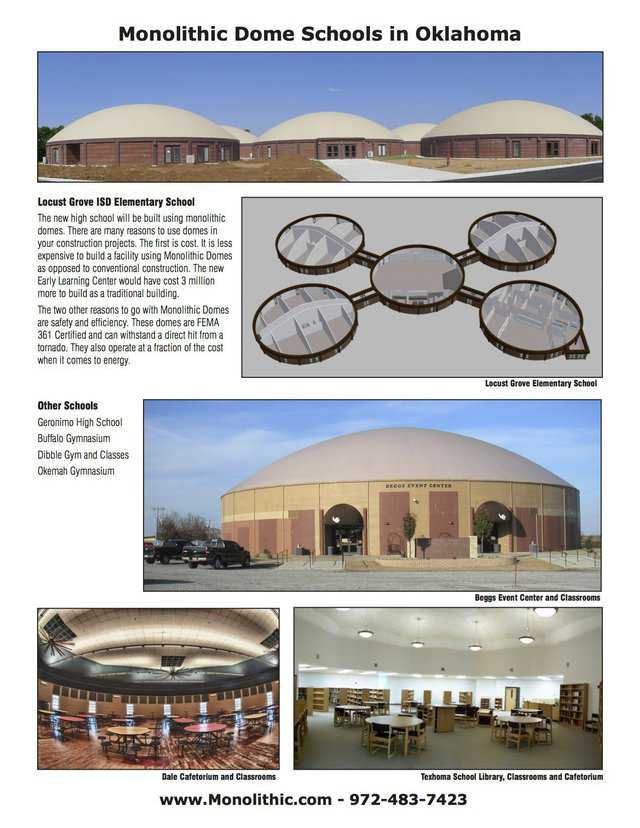
School children were killed in the tornado that hit Moore, Oklahoma in the spring of 2013. That need not happen at your school – or any school. It is possible to have A TORNADO-SAFE and AFFORDABLE SCHOOL.

Today’s schools have two relatively new, major problems: 1) How to keep students safe; 2) How to design and maintain a campus that provides what the community needs and does it affordably.
The Oklahoma City FOX affiliate KOKH TV online investigative report features part two of a special report about how Monolithic domes at one school could become the model for schools everywhere.
In an article in the News-Star.com, of Shawnee, Oklahoma, it is discussed how Oklahoma public schools are being pressured to install safe rooms. Dale Public Schools and others are touted as already having done so with their Monolithic Domes.
A recent news article at KMOV-St. Louis features a video interview with Valley R-6 officials in Caledonia, Missouri. Quoting, ‘At first glance the five domes that make up Valley R-6 Elementary School in Caledonia, Missouri look odd, but school officials say they are the safest buildings in the face of a tornado. “They are tornado proof – hurricane proof – fire proof and so our kids are very safe,“ says Valley superintendent Brad Crocker.’
It’s time to solve the tornado problem, once and for all

Can a School Get a FEMA Grant to Build a Monolithic Dome? A professional grant writer’s answer: Anne (Williams) Danysh of Real Grant Solutions gives us her assessment of a school’s chances for getting a FEMA grant to build a Monolithic Dome. Anne significantly assisted the school district in Woodsboro, Texas that, in April 2009, received a FEMA grant of $1.5 million. Two years later Woodsboro celebrated with a grand opening of its 20,000-square-foot Monolithic Dome. That multipurpose dome serves as a gym, auditorium, activity center and community disaster shelter.
One of the first things children learn when they go to school is how to add and subtract. As officials in Locust Grove, Oklahoma were contemplating building a Monolithic Dome school, simple math convinced them it was the only way to go.
The inflation of Canada’s first Monolithic Dome school structure was big news, as teachers, students and local media were on hand to see the structure take shape. “Raise that dome,” chanted students as construction crews used giant fans to inflate the Airform at Southamton’s G.C. Huston school. The structure, which will be open on four sides and house outdoor classrooms, is scheduled for completion in September.
Every spring, tragic stories abound of the devastating effects of tornadoes. One such example is the EF-5 tornado that ripped through Smithville, Mississippi in April 2011. In addition to destroying numerous town structures, this particular tornado passed right over the high school and flattened the gym.
Why are so many school districts building Monolithic Domes? Energy efficiency is definitely near the top of the list. But the fact that the Federal Emergency Management Agency is helping fund construction of these tornado-resistant structures has fueled a mini building boom of sorts.
FOR IMMEDIATE RELEASE
School districts in tornado- and hurricane-prone areas of the United States have discovered the benefits of building Monolithic Domes to combat the fury of Mother Nature. Not only are the dome school structures energy efficient, they also can double as community disaster shelters.
Interest in Monolithic Dome schools has hit an all-time high in part because the Federal Emergency Management Agency is helping fund new construction in tornado-prone areas. Archie R-V School District recently completed a new Monolithic Dome gymnasium that was funded in part by a $1 million FEMA grant, according to the Bates County Newswire.
An Oklahoma school district is hoping to receive a grant from the Federal Emergency Management Agency to supplement a $1.7 proposed bond issue needed to fund new construction. Hulbert Public Schools in Hubert would use the federal money to finance a new Monolithic Dome elementary school and cafeteria that would double as community disaster shelters.
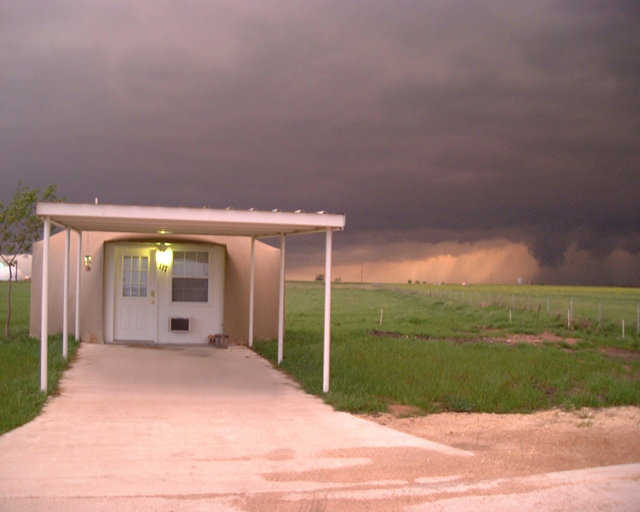
There is no such thing as a free lunch, but the Monolithic Dome comes close. The original cost of a Monolithic Dome is generally less than that of a similar- size conventional building. Often it is much less. Then there is cost recovery. Generally, over a period of twenty years, savings in energy costs will equal the full cost of a Monolithic Dome facility. So, in effect, it becomes free.

Monolithic’s David B. South traveled to South Texas recently for the dedication of the new Eagle Dome at the Woodsboro Independent School District. The new Monolithic Dome, which was financed in part by the Federal Emergency Management Agency (FEMA), is being billed as a prototype for shelters of last resort in coastal areas, according to the Corpus Christi Caller-Times.
Monolithic Domes make fantastic schools. Ward Huffman of the Department of Energy called them “self-replicating.” Generally, Monolithic Dome schools pay for themselves in energy savings within 20 years.
When a multipurpose Monolithic Dome opened in Fowler USD earlier this year, it made news. Not only was it the first dome school building in Kansas, but the Federal Emergency Management Agency funded a substantial portion of the construction costs.
This video presents comments and information from superintendents, principals and teachers of Monolithic Dome schools in several States. Some talk about the advantages of going Monolithic because of significantly lower construction costs that influenced voters to pass bonds. Others comment on the energy-efficiency, affordable maintenance, and lower insurance premiums that Monolithic Dome schools enjoy. Still other comments focus on the dome’s ability to meet FEMA standards for near-absolute tornado protection, the design flexibility of a Monolithic Dome, and its use for community as well as school events.

$322 billion! That, says the National Education Association in its Statistical Analysis Report of June 2000 is the staggering amount it will take to fix America’s schools. Of that $322 billion, about $54 billion should be allocated for educational technology. But the remaining $268 billion is needed to repair, renovate or add to existing school facilities.
Oklahoma is home to more Monolithic Dome schools than any other state in the nation. It will soon have one more as Dale Public School completes construction on a new steel-reinforced concrete dome facility that will serve as an events center and cafeteria. The 109-foot-diameter building is scheduled for completion in January 2012.
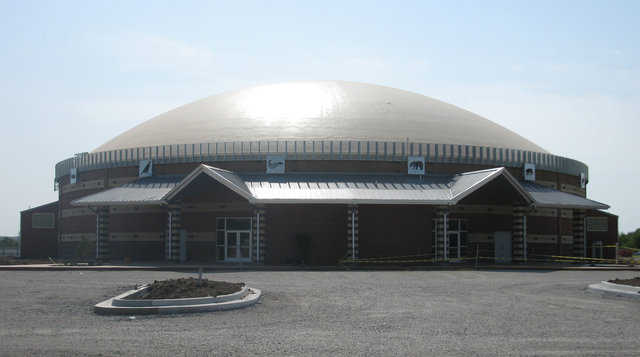
The Muscogee (Creek) Nation is planning a grand opening for its new $4 million Monolithic Dome multipurpose facility in Okmulgee, Oklahoma.
At a presentation to a school board, I ran into an interesting situation. One of the school board members said, “It is extremely important that we bid this project out.” He was inferring that if they selected a Monolithic Dome they wouldn’t be able to bid it. I explained that there were several people who could bid the Monolithic Dome and that every single piece of the construction of any school building had to be bid. On further reflection, I realized how fickle the bid process is.
I don’t know of a high school or college that would not like a state-of-the-art, indoor stadium. But before Monolithic developed its technology such an undertaking was far too expensive. That is no longer true. High schools and colleges can now build a Monolithic indoor stadium for about what they would pay for an outdoor football stadium.
The deadly tornadoes that hit the southern United States were a vivid reminder of the tragic consequences that ensue when people do not have a safe shelter during severe weather. They also served to make Fowler school officials even more grateful that they had the foresight to build a Monolithic Dome multipurpose building to house their new gymnasium, band/vocal room and computer lab. The building, which is the first of its kind in Kansas, was funded in part by a $345,000 grant from the Federal Emergency Management Agency.
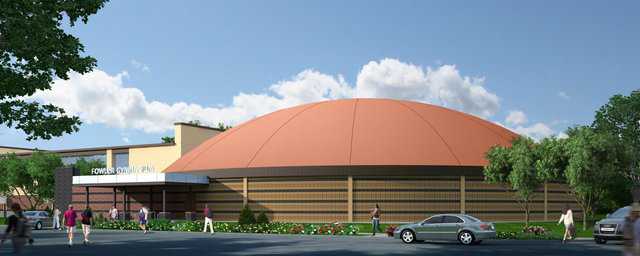
On Wednesday, May 11th, Fowler USD 225 in Fowler, Kansas will host an all-day, gala event celebrating the opening of their Monolithic Dome gymnasium, and they’re inviting everyone! Superintendent Sam Seybold put it this way. "We want a good turnout. I think it’s really important, especially with what’s been happening with the tornadoes in the South, for schools and communities to know (about Monolithic Domes).
Articles on Monolithic.com featuring the Avalon dome.

Woodsboro, Texas is a small, agribusiness community near the Texas Gulf Coast that has about 1700 people and a high school with just 700 students. But Woodsboro ISD managed to get a FEMA grant of $1.5 million to build a Monolithic Dome multipurpose center/disaster shelter whose grand opening is scheduled for this May.
Charter schools are known for their innovative curriculum and pioneering strategies. It is fitting, therefore, that the Career Success Charter High School in Phoenix has housed its newest campus in four monolithic domes. Located just east of downtown, the brightly colored structures are painted to look like planets - Earth, Jupiter, Saturn and Neptune. The buildings are also totally solar powered and equipped with the latest technology.
U.S. Rep. Ruben Hinojosa, D-Mercedes, was back in his home district recently handing out checks to local organizations that have qualified for federal grant money. Congressman Hinojosa also took the opportunity to tour a new Monolithic Dome school building that was funded by federal grant money last year - the Woodsboro gymnasium/community center.
Articles regarding the Caledonia School District of Missouri featured on the Monolithic website.

Caledonia’s website proudly says that it has 33 homes on the National Historic Register, and its mayor states that visiting this “village” is like “stepping back in time – a 100 years back in time.” While all that is true, Caledonia also has five of the most modern structures available today: five Monolithic Domes.
Robert L. Duffy High School, which will open its doors this fall in Phoenix, is a different kind of school. While it does offer core curriculum classes in English, math, social studies and science, it also has career-focused classes designed to help students get an entry-level job in the field of their choice. It’s fitting, therefore, that this innovative curriculum will be housed in innovative buildings—three monolithic dome school buildings to be exact.
It took four bond elections and more than six years, but the small Kansas town of Leoti is finally getting a new Monolithic Dome school to replace its 85-year-old elementary school building. A ribbon cutting is scheduled for May 19 on the first of three dome structures that are under construction.
Metro News is Canada’s largest free national newspaper reaching about 1.1 million readers from coast to coast. This week, the paper’s environmental columnist put the focus on Monolithic Domes, proclaiming that dome-shaped schools just may spark a building revolution.
Articles pertaining to the Grand Meadow School district on the Monolithic website.
A third school district has received a grant from the Federal Emergency Management Agency (FEMA) to build a Monolithic Dome school. The Dodge City Daily Globe is reporting that FEMA will provide a $345,000 grant to USD 225 in Fowler, Kansas to cover a portion of the construction costs of a new school facility, which meets standards for near-absolute protection from tornadoes and hurricanes.

The Muscogee (Creek) Nation recently broke ground a 160-foot diameter Monolithic Dome multipurpose facility adjacent to an existing sports complex in Okmulgee, Oklahoma. The Muscogee Phoenix newspaper covered the groundbreaking of the $4 million facility, which is scheduled for completion in 2010.

The Muscogee (Creek) Nation is making plans to build a 160-foot diameter Monolithic Dome multipurpose facility adjacent to their existing sports complex in Okmulgee, Oklahoma. The $4 million facility, which will encompass more than 20,000 square feet, will include spectator seating, classrooms, concessions and several multi-use areas. Construction is set to begin in late summer and will be completed in 2010.
A small Missouri school district that recently completed the last of three Monolithic Domes, will begin construction this spring on two more dome buildings to accommodate students in kindergarten through second grade. Valley R-6 School District in Washington County plans to build the two new dome structures on the same site as the three existing domes.